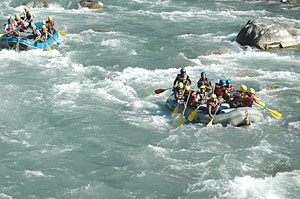 |
 |
But when people speak of Nepal's water resources, they tend to mean only hydropower. Yet, our rivers have great economic, social, cultural, and ecological significance. Geologists say Nepal's main rivers are actually older than Himalaya, which is why many of them have their origins behind the main range in Tibet. And just as we revere the mountains, our rivers are also holy. With global warming, Himalayan rivers are going to be more and more important as a source of survival.
Even from an economic standpoint, a river's tourism potential may be more important than hydropower. Nepal therefore cannot afford to destroy nature only for the sake of hydropower, no matter how severe the current energy shortage. Destruction of nature is irreversible, once it's gone it is gone forever.
Nepal can only prosper if our nature-based tourism, agriculture, trade, cottage industries and hydropower are developed together: not one at the expense of the other. Before damming a river for energy, we must look at the long-term cost of that action. We may generate power, sell it to India, but will that create jobs within the country? How will it impact tourism, culture and the ecology along the river?
Energy is no doubt needed to power our homes and industry. But small and medium hydro schemes with low cost, low maintenance, and low footprints are more appropriate and sustainable. Small is not just beautiful, it is wise.
Already, most of our bigger rivers have been blocked off by businessmen who are sitting on licenses. This is a recipe to make the rich richer and the poor poorer. A resource that should belong to all Nepalis have been grabbed by a few individuals with connections. And since big projects mean big kickbacks, politicians and businessmen are in cahoots to back bigger and more destructive projects on our rivers.
Nepal's topography is like a staircase rising from 80m above sea level along the southeastern plains to above 8,000m. Most of our rivers emerge from glacier snouts at about 6.500m.
This balance can be reached if we demarcate hydropower development on rivers between 1,200-5,000m, set aside rivers between 200-1,200m for tourism and conservation and sections of rivers between 80-200m for irrigation.
In addition, we must protect some rivers as free-flowing. Just as there are national parks to protect landscapes rich in biodiversity, we must protect certain rivers. The Humla Karnali could be declared a Himalayan River Heritage, while its tributaries can be set aside for hydropower and irrigation.
Similary, since the Kali Gandaki, Marsyangdi and Trisuli in central Nepal have already been dammed for power, we should leave the Madi alone as a heritage river. In eastern Nepal, the Tamor deserves to be reserved as a free-flowing river.
Keeping the Karnali, Madi and Tamor free from hydropower development will not mean a big loss in generation capacity, but these rivers will be kept in their pristine state for future generations. In addition, discouraging construction of dams on major rivers below 1,200m will protect them for adventure tourism and rafting.
Current plans to build the Chilime project on the Bhote Kosi is a bad idea because it will block a stretch of river that is considered one of the top ten rivers for white water rafting and kayaking. Nepal can host international competitions on these rivers and generate much more revenue than one more hydropower plant can.
Nepal needs a long-term strategy for our rivers that balance our economic needs with our responsibility to protect the ecology of our rivers.
Megh Ale, an Ashoka Fellow, also heads the Nepal River Conservation Foundation.
Read also:
Generate electricity, or protect tourism?, PAAVAN MATHEMA in SINDHUPALCHOK
Nepal's need to generate hydropower must not destroy the potential of its rivers for adventure tourism
See also:
Liquid gold, WONG SHU YUN in SINDHUPALCHOK
Hydropower and rafting sectors vie for rivers
Take me to the river
The Bagmati River Festival celebrates its 10th anniversary this year. Organiser Megh Ale of the Nepal River Conservation Trust spoke to Nepali Times about what he is trying to achieve:



